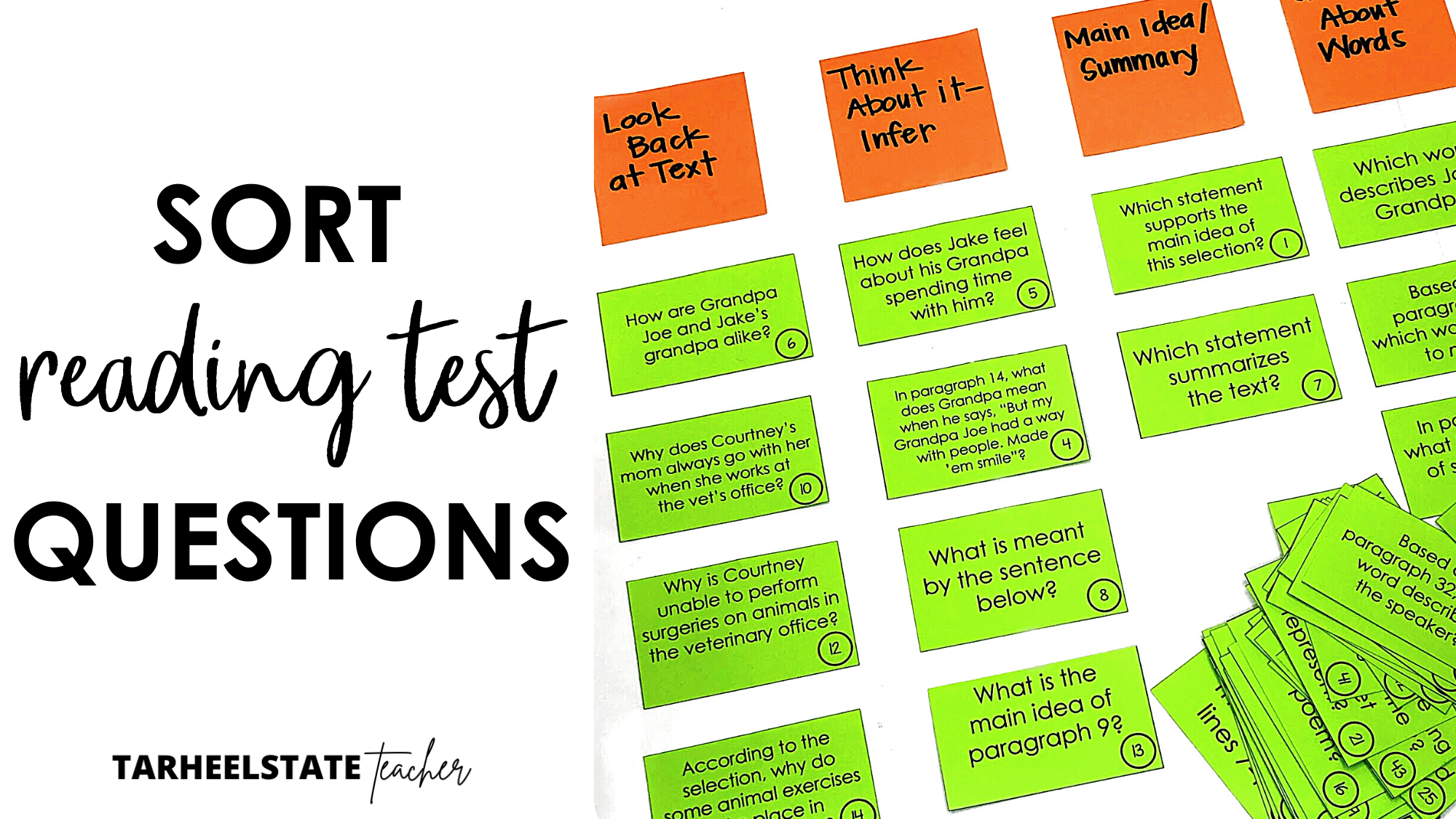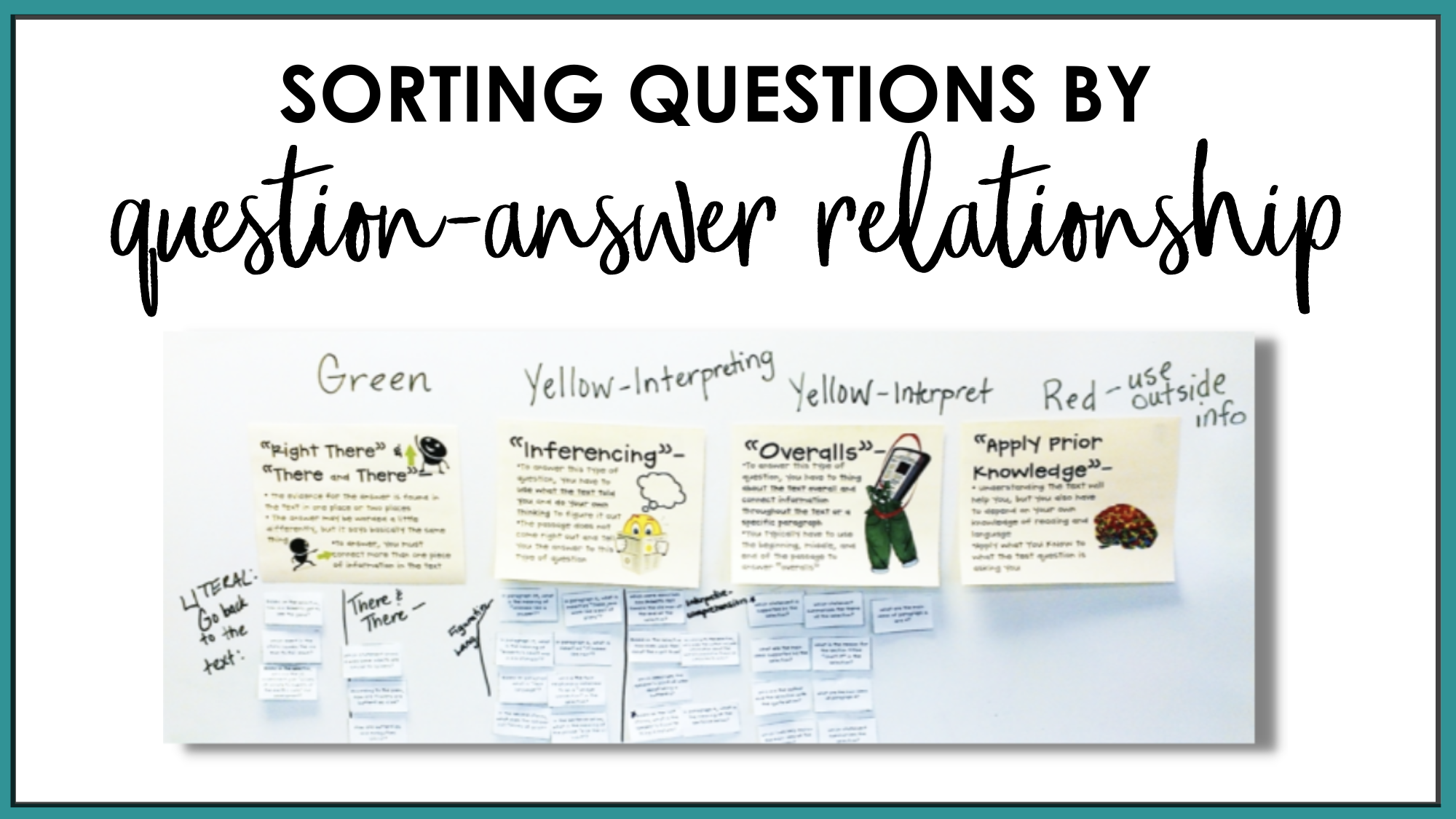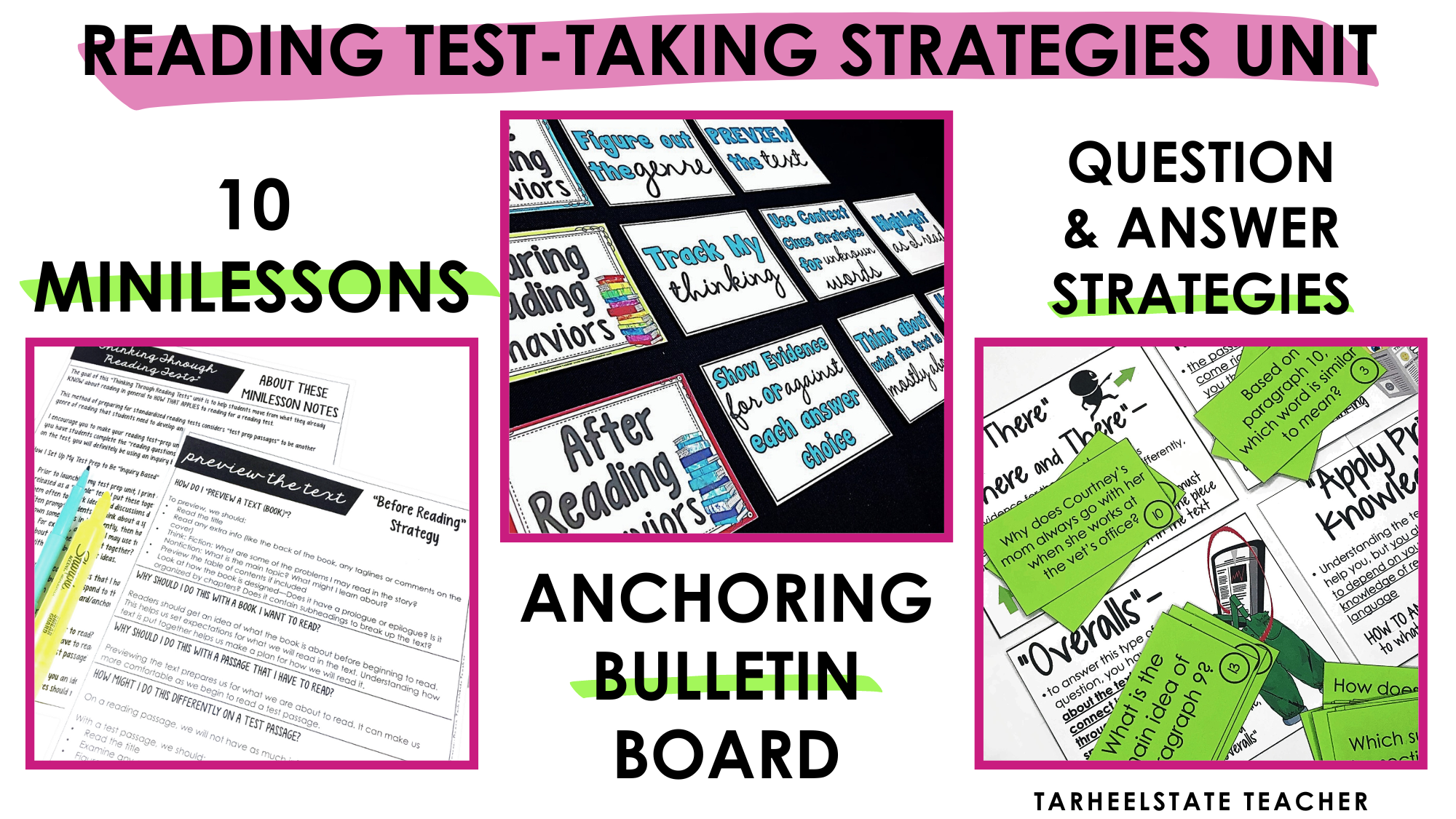Sorting Reading Questions: Launching Your Reading Test Prep Strategies Unit
In my last blog post, I shared the Thinking Through Reading Tests Framework for preparing students for standardized reading tests through an inquiry-based process.
Today I wanted to share how I get my students thinking about the types of questions they can expect on the standardized reading test through a question sorting activity. This is the first activity I use when my students are ready to start answering comprehension questions during our test prep unit for our NC ELA EOG (end-of-grade state test). Before they jump right in, I teach my students about question-answer relationships and I teach specific strategies for answering multiple-choice reading comprehension questions.
To prepare for my test prep unit, I get my reading test bulletin board set, the released reading passages, and my question sorting sets all printed out and ready to go. You can get the question sorting sets along with a few other useful test-prep tools sent straight to your inbox for free!
Day 1: Sort Reading Test Questions with Partners
To launch our study of the types of questions we will be asked on the reading test, I have my students complete a partner sort using the test questions found on the released version of the NC Reading EOG.
To complete the sorting activity, students work in partners to sort the questions into categories that make sense to them. They look for similar questions, patterns, and other connections as they place the questions into groups.
It is always interesting (and telling) to see what categories students come up with on their own. As they work, I go around from group to group listening to students' ideas and pushing them to reconsider how they have categorized their questions.
We complete this sort PRIOR to students reading any passages to give students exposure to the types of questions that they will be asked. Based on my experience, I've found we can learn about what we can expect on the standardized reading test as we make generalizations about the types of questions that keep popping up in the question sets.
When students have finished sorting, they can label their categories with sticky notes. One option for sharing their ideas is to have everyone rotate to one another's work. They can think about similarities and questions they have for the partners.
At the end of the partner sorting activity, I bring students back together and guide them in discussing their findings. I ask each group to share the categories they decided on, discuss any questions that didn't seem to fit a group, and I jot down the different categories they share on chart paper.
Day 2: Introduce Question-Answer Relationships (4 Question Types)
On day two, I introduce students to the 4 Types of Questions that are my own revision of Question-Answer-Relationship question types. If you are unfamiliar with QAR, it basically helps us label questions as certain types so that we know how to go about answering them.
To prepare for the minilesson, I post the four question types on my whiteboard.
"Right There" and "There and There"
These questions require us to look back into the text to find evidence for the answer. The correct answer choice may be worded a little differently that what it states in the text, but it says basically the same thing. We must connect one or two pieces of information in the text to answer the question.
"Inferencing"/"Interpreting"
For these questions, the passage does not come right out and tell us the answer. We have to interpret by using what the text told us and our own thinking to answer the question.
"Overalls"
These questions are our main ides and summarizing questions. We have to think about the text "overall" and connect information throughout the passage or a specific paragraph. We typically have to connect information from the beginning, middle, and end of the passage or paragraph to answer "overall" questions.
"Apply Prior Knowledge"
With prior knowledge questions, understanding the text will help us answer the question, but we have to rely on our own knowledge of reading, the way texts are designed, and language. To answer these questions, we have to apply what we know to what the test question is asking us.
I give students a Question-Answer-Relationship handout. (Grab the bulletin board posters and student handout). As I walk them through each type of question, I have students reflect on the categories they used in their own sort the day before. I ask if anyone had a category that they think they could now call "Right There" or "There and There" or "Overalls" as I go through each one.
Next, I have students meet with their partner again to sort the questions into these four categories. Again, I rotate the room, probe, ask questions, and make sure students understand the descriptions of the four question types.
Now, not having read the text yet, there are a few questions that may seem to fall between two of the types of questions, but the point is that students learn to "think through" the four question types they will see on the standardized reading test.
(Modification: If you have the time to spend on increasing the inquiry for this test question exploration activity, you can actually work as a class to categorize all of the questions. As you go through each question, have the class agree upon whether or not the question fits into a category you've already established or needs its own category. Tape them to your whiteboard as you sort them. You can guide students to "discover" the 4 types of questions I've described-- it just takes a little more time discussing and working together in whole group.)
Day 3: Sorting Questions together with QAR Categories
In this follow-up ELA test-taking strategies minilesson, I give each student two of the question cards and start the lesson with a few questions that I keep for myself. (You can do this totally randomly, no strategic planning needed here unless you want to make sure you have one example of each type of question).
I read aloud one of my questions and we discuss which category it should be placed under. For example, "How are Grandpa Joe and Jake's grandpa alike?" To answer this question, I will have to put together pieces of information that have been shared with me throughout the text. I'd classify this as a "There and There" question. I'm going to assume that the text supports me a lot when trying to answer this question. Based on the things I've been told about Grandpa Joe and what I've been told about Jake's grandpa, I will find a similarity. This is a literal kind of question and I will go back to the text to gather evidence to help me answer it.
Next, I ask students to raise their hands and share if they have a question like the one we've just categorized.
Students read their questions one-by-one and we decided as a class if the questions fit the category that we are discussing. We continue until we've grouped and classified all questions.
You can see the results of this ELA test-taking strategy minilesson in the picture below. (We also use a "comprehension stoplight" for our levels of thinking about reading, so you will that we also connected our green, yellow, and red type of thinking to the types of questions in the picture).
Within the 4 categories for QAR, you can also see if students can come up with different types of questions that fall into each category. For example, “overall” questions include main idea, summarizing, theme, etc. while “inferencing” questions also include context clue questions because you use the text and your mind to infer word meaning.
Further classifying these questions under your 4 umbrella question types will help students continue to make generalizations and connections about the types of questions they can expect on the test.
Here's how some of our example questions fell into the categories:
"Right There" and "There and There" Questions
➥ Based on the selection, how did Roberto get to see the game?
➥ "How are butterflies and mosquitoes different?"
➥ "Which statement shows a way some insects are similar to spiders?"
(The last two are both Compare/Contrast Questions where we will need us to use information in two different places in the text to answer).
"Inferring"/"Interpreting" Questions
➥ "In paragraph 19, what is meant by 'Roberto's heart was in his stomach?"
➥ "In the selection, what can be inferred about how the people viewed the old man?"
➥ "What does the word shabbily mean as it is used in the text?"
These questions require interpreting figurative language, using context clues for unknown words, and other comprehension questions that go beyond the literal.
"Overalls"
➥ "Which statement summarizes the theme of the selection?"
➥ "What main ideas are supported by the selection?"
Overalls include main idea, summary, theme, generalizations, author's point of view, the overall message of the story, etc.
"Apply Prior Knowledge"
It's hard to classify questions on the standardized reading EOG test as "prior knowledge" questions. Almost all of the questions for our reading test are text-dependent. However, students' prior knowledge of word meanings, figurative language, and techniques used in different genres will surely help them understand what they read and influence their ability to answer questions on the reading test.
If you think about the "Roberto's heart was in his stomach" question, I know what this means without reading the text, but I don't want to encourage students to answer questions with referring back to the text to collect evidence for their answer.
WHY TAKE THE TIME TO TEACH QUESTION-ANSWER RELATIONSHIP?
Each of these categories helps students tap into the skills and strategies they should use to answer the questions given. For example, if I have an overall question, I am going to pull from the beginning, middle, and end of the text (or a specific paragraph).
When students get stumped by a question, I always ask them what type of question it is. Then, I follow up with, so what does that mean you should do?
What’s the purpose of having students sort the test questions independent of reading the text?
Allowing students to closely analyze questions helps them to make generalizations about the types of questions they can predict will be on the standardized reading test and the questions they can expect for specific genres. Yes, you as the teacher can do all of the analysis work for students and hand them a list of questions, but allowing students to come up with generalizations about the test questions takes your ELA test-taking strategies prep from teacher-centered to student-centered and considers testing as “genre” or “type of text” rather than an unpredictable “test.”
Really, a lot of the test is predictable.
For example 👉
I'm going to expect questions about main idea and summarizing when reading a nonfiction passage.
I'm going to expect questions about the author's message or what the character learned when reading fiction.
Based on the number of questions in our question sort that ask about word meanings and language interpretations, I will need to understand what I read and be able to re-word that. Review lessons on how to use context clues and perhaps some extra practice will come in really handy prior to our standardized reading test!
These are the kinds of things YOU can learn when studying the reading test questions from your own state’s standardized ELA test!
Want to grab the QAR handouts, my minilesson framework for teaching and reviewing reading strategies, and the 4-Step process I have my students go through to answer reading questions? You can also grab the full Thinking Through Reading Tests unit materials, designed from 11 years of experience in preparing students to take the North Carolina ELA EOG in 4th and 5th grades. It includes minilessons that help you teach students what they should do before, during, and after starting to read their test passages, anchor charts and bulletin boards to help you organize all of your minilessons, and two strategies that help students learn how to answer test questions.
Want more ideas for helping your students “Think Through Reading Tests”?
→ A Framework for Preparing for Standardized Reading Tests
→ Sorting Reading Questions Activity (to launch your reading test questions unit)
→ Reading Test Prep Mini-Lessons (an overview of the lessons I teach)
→ 4-Step Process for Answering Multiple Choice Reading Questions
→ Ways Teachers Prepare Students for Standardized Reading Tests without Mentioning the Words (an ODE to how awesome you really are!)
→ My Thoughts about Teaching Students to Read Questions First as a Test Prep Strategy (don’t do it!)







